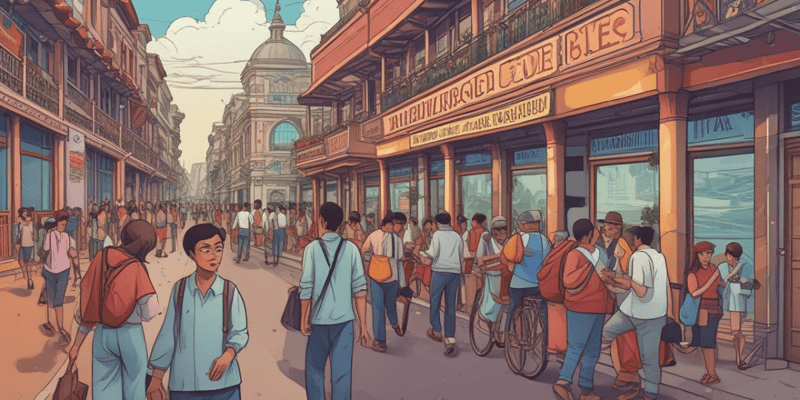10 Questions
What is the main criticism of the Philippine government's spending on education?
The government has not been spending enough on education and has not been spending well what little it has.
What is the characteristic of education governance in the Philippines?
High concentration of resources at the national level, unmaximized local resources, and low levels of autonomy at the local level.
What is the recommended model of governance for Philippine basic education?
A fiscal decentralization model that aims to ensure adequacy, equity, efficiency, and performance of education services.
What is the cumulative expenditure per student in the Philippines, according to the OECD?
About USD 11,000 (PPP) over ten years of age between 6 and 15.
What is the percentage of learning poverty in the Philippines, according to the World Bank?
90%
What is the relationship between education expenditure and student performance according to PISA data, and what implication does this have for the Philippine government's spending on education?
The relationship is that education expenditure is related to student performance only up to a certain point, implying that the Philippine government's current spending on education may not be sufficient to achieve significant improvements in student performance.
What is the significance of the USD 75,600 (PPP) threshold in the context of education spending and student performance?
The USD 75,600 (PPP) threshold is the point at which economies saw a variation of 27% in their math scores explained by increased education spending, indicating that the Philippine government's current spending is significantly below the level required to achieve significant improvements in student performance.
What is the implication of the 90% learning poverty rate in the Philippines, and what is the recommended solution to address this issue?
The 90% learning poverty rate implies that the majority of students in the Philippines are unable to read and understand a simple text by age 10, and the recommended solution is to increase education spending to reach the global reading proficiency standard, which would require a quadrupling of the current spending.
What is the significance of the increase in the share of education, culture, and sports development in the national budget from 2020 to 2024, and what more needs to be done to address the learning poverty crisis?
The increase in the share of education, culture, and sports development in the national budget from 2020 to 2024 is a positive step, but it is still insufficient to address the learning poverty crisis, and more needs to be done to increase education spending to reach the global reading proficiency standard.
What is the significance of the PISA 2022 results, and what do they imply about the effectiveness of the current education policy in the Philippines?
The PISA 2022 results show some improvements in raw scores in reading and math, but the learning poverty rate remains high, implying that the current education policy is not sufficient to address the learning poverty crisis, and more needs to be done to improve education outcomes.
Study Notes
Education Spending in the Philippines
- The Philippines has not been spending enough on education, and the spending is inefficient.
- Research shows that the amount of resources and how they are used significantly impact learning outcomes.
Current State of Education Governance
- Education governance in the Philippines is characterized by a high concentration of resources at the national level.
- Local resources are not fully utilized, and local autonomy is limited.
Recommended Solution
- A fiscal decentralization model of Philippine basic education governance is recommended to ensure:
- Adequacy of education services
- Equity in education services
- Efficiency in education services
- Performance of education services
Education Expenditure
- The cumulative expenditure per student in the Philippines over 10 years (between 6 and 15 years old) is approximately USD 11,000 (PPP).
- This is significantly below the USD 75,600 (PPP) threshold, where increased education spending explains 27% of the variation in math scores.
Government Efforts
- The government has increased the share of education, culture, and sports development in the national budget:
- From 15.76% in 2020 to 17.05% in 2024
- However, the government needs to quadruple its spending in education to reach the global reading proficiency standard.
Learning Poverty
- Learning poverty, defined as the inability to read and understand a simple text by age 10, is still at 90% in the Philippines (World Bank).
- PISA 2022 results show some improvements in raw scores in reading (+7) and math (+2), and a one-point increase in the global ranking.
Education Spending in the Philippines
- The Philippines has not been spending enough on education, and the spending is inefficient.
- Research shows that the amount of resources and how they are used significantly impact learning outcomes.
Current State of Education Governance
- Education governance in the Philippines is characterized by a high concentration of resources at the national level.
- Local resources are not fully utilized, and local autonomy is limited.
Recommended Solution
- A fiscal decentralization model of Philippine basic education governance is recommended to ensure:
- Adequacy of education services
- Equity in education services
- Efficiency in education services
- Performance of education services
Education Expenditure
- The cumulative expenditure per student in the Philippines over 10 years (between 6 and 15 years old) is approximately USD 11,000 (PPP).
- This is significantly below the USD 75,600 (PPP) threshold, where increased education spending explains 27% of the variation in math scores.
Government Efforts
- The government has increased the share of education, culture, and sports development in the national budget:
- From 15.76% in 2020 to 17.05% in 2024
- However, the government needs to quadruple its spending in education to reach the global reading proficiency standard.
Learning Poverty
- Learning poverty, defined as the inability to read and understand a simple text by age 10, is still at 90% in the Philippines (World Bank).
- PISA 2022 results show some improvements in raw scores in reading (+7) and math (+2), and a one-point increase in the global ranking.
This quiz covers the fiscal decentralization of basic education in the Philippines, highlighting the importance of resource allocation and governance in improving learning outcomes.
Make Your Own Quizzes and Flashcards
Convert your notes into interactive study material.
Get started for free



